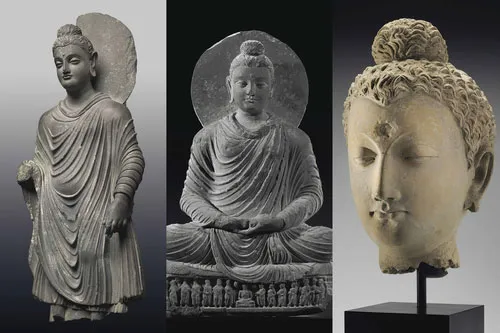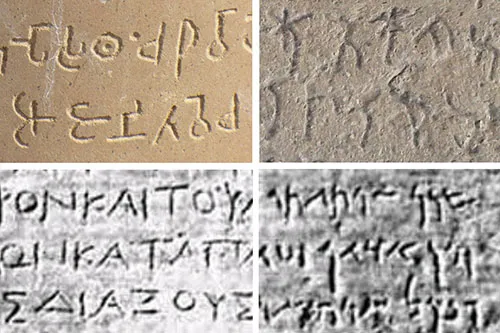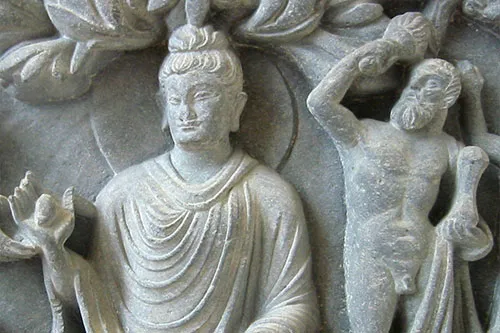
Greco-Buddhism
Hellenism and Buddhism
Greco-Buddhism, or Graeco-Buddhism is a term used to describe the cultural mixture of Greek culture and Buddhism, which began in the 4th century BC. with the beginning of the Hellenistic period, and continued until the 5th century.
It was a cultural consequence of a long chain of events, and the interaction between the Greek element and Buddhism began with the campaigns of Alexander the Great and the conquest of the Persian Empire, and further conquests in areas east of Central Asia, where today the countries of Afghanistan, Pakistan, Uzbekistan, Tajikistan and Turkmenistan to the north, and the Indus River to the south and the Ydaspis to the east, reaching the Ifasi River, thus establishing a direct contact with the cultures of India.
These campaigns and the creation of the Hellenistic Kingdoms in India created the conditions for Greeks to contact Buddhist teaching and establish Buddhist communities. The regions from which it originated include those of modern Afghanistan, Pakistan and India.
Nevertheless, few people today know that the Greeks were the first Europeans to embrace Buddhism centuries before the advent of Christianity, and there is strong evidence that the first sculptors to depict the Buddha in the form of statues were of Greek descent.
These statues present a realistic treatment of the folding of the robes and the management of the total volume, similar to the best Greek creations, and which belong to classical and Hellenistic Greece.
From the 4th century BC. The philosophical, peaceful and liberating Teaching of the Buddha had a great impact on Hellenism, when there was a great interaction of Greek and Buddhist cultures in Asia. In fact, something even fewer people know, the Greeks of the Hellenistic Kingdoms of India were the ones who played an important role in the spread of Buddhism.
Thus, the Greek Buddhist monk Ntammarakchita (Dhamma-rakkhita-title means protected by Teaching), he was one of the missionaries sent by the Buddhist emperor Ashoka, the spread of Buddhist teaching in the northwestern part of the Indian peninsula (aparantaka). There he preached the Aggikkhandhopama Sutta and converted 37,000 people to Buddhism. This reference is found in the great Sri Lankan chronicle “Mahavansa” (Mhv.xii.4, 34f.), Where Dammarakhita is described as a Greek (Jonaka).”Gionaka” (Yonaka), “Jonna” (Yona), or “Giavana” (Yavana), which literally means “Ionas / s” is the name by which the Greeks were described in ancient times throughout the classical world. They were ardent followers of Buddhism, and the example of the Greek (Jonaka) Dammarakhita shows that they even took an active role in the spread of Buddhism as leading missionaries.
Few know that the Buddha himself around the fifth century BC. in one of his teachings he referred to the Greeks (Yona, the Indians of the time), when he compared the rigid social system of the four Indian classes or castes with that of the Greeks and other neighboring countries where there were only two classes of people, the despots and the slaves, and where the despot could become a slave or vice versa. (MN 93, Assalāyana Sutta).
Besides, Greek was one of the first languages in which part of the Buddha’s teachings was recorded, long before the Canon Again, in the famous columns and inscriptions of the Indian Emperor Ashoka. The following text is part of the teachings of the Buddha and was found in one of the 14 largest inscriptions written in Greek:
[Εὐ] σέβεια καὶ ἐγκράτεια κατά πάσας τάς διατριβάς
“Piety and restraint in all ways of life”
ἐγκρατὴς δὲ μάλιστά ἐστιν ὃς ἂν γλώσης ἐγκρατὴς ἦι.
“In fact, he is the one who is restrained in language”
Καὶ μήτε ἑαυτοὺς ἐπα [ι] νῶσιν, μήτε τῶν πέλας ψέγωσιν περὶ μηδενός
“And neither to praise themselves, nor to criticize their neighbors (neighbors) for insignificant things”(Stone Inscription of Ashoka in Kandahar, 258 BC)
This teaching is also found in the texts of the Canon Again which is the official language of the Buddha’s teachings.
Emperor Ashoka adopted the Buddhist faith and became a major convert to Theravada Buddhism under the traditional Canon Again, insisting on non-violence against humans and animals, and general exhortations to regulate the moral life of humans. It is a historical figure that constitutes for Buddhism what the Roman emperor Constantine I constitutes for Christianity. He came to power around 270 BC. and his kingdom is associated with the pinnacle of power of the Mauryan dynasty.
According to the inscriptions of Ashoka, which are engraved in stone, and some of which are written in Greek, he sent Buddhist representatives to the areas of the Greeks in Asia, as well as to areas as far as the Mediterranean Sea. In these writings, each of the leaders of the Greek world who met at that time (in the middle of the 3rd century BC) is mentioned:
“Conquest with Dharma (Teaching) has been won here on the border, as well as even in the six hundred yojas (4000 miles / 6437 km) away, where the Greek king Antiyoga (Antiochus II the God – Seleucids) rules, and beyond the earth there are four kings named Turamaya (Ptolemy Philadelphia – Egypt), Atiyoka (Antigonus II Gonatas – Macedonia), Maka (Magas the Cyrenean – Cyrenaic) and Alikasu [ n ] dara (Alexander of Epirus, with) the same way that Tsola, Padia, and Tambara (Sri Lanka) do in the south”. (Decree 13).
Ashoka also claimed to have converted the Greek populations of his kingdom to Buddhism:
“Here in the land of the king among the Greeks, the Cambodians, the Nabhaks, the Nabhapamkits, the Bhojas, the Pitniks, the Andhras and the Palindas, everywhere all the people follow the teachings of the Dharma”. (Decree 13).
The cultural consequence of Greek culture and Buddhism continued with the founding of the Greek kingdom of Bactria (250 BC – 130 BC), where present-day Afghanistan is located. This extended deeper into India in 180 BC, where the Indo-Greek kingdom was founded, under which Buddhism spread widely. Thus Buddhism prospered under the rule of the Greek-Indian kings. The Greek-Indian kings combined Greek and Indo-Iranian languages and symbols and the religious customs of Hinduism, Buddhism, and the ancient Greek religion. They were also proponents of Buddhism — a combination now known as Greek Buddhism and Greek Buddhist art.
Menander AD, who has been described as the greatest and most famous of the Greek-Indian kings, is considered a great patron of Buddhism. He was one of the kings of the Indo-Greek kingdom from 163 BC. until 145 BC. Known as Menander, the Righteous had its capital in Sāgala, present-day Sialkot in Punjab, Pakistan. He embraced and promoted Buddhism, and in Indian tradition is called Milinda.
The dialogues with the Buddhist monk Nagkasena (Nagasena), who is known for his turn of Menander by ancient polytheism in Buddhism are the Buddhist treatise called ‘Pancha Milin, “which means,” The Questions of Menander. ” Menander came to enlightenment as a sage under the guidance of Nagasena.
The Buddhist tradition recognizes Menander as one of the great benefactors of the faith, along with Ashoka and Kaniska. Besides, it is possible that Menander did some proselytizing work as during his reign there was a large number of Greek Buddhist monks in the Greek cities where he ruled.
Thus, according to the chronicle “Mahavansa”, Maha Dhammarakkhita (Mah ā Dhammarakkhita), was a Greek Buddhist monk during the reign of Menander who, around 130 BC, led 30,000 Greek Buddhist monks from the Greek city of Alasandra “(Alexandria or the Caucasus, about 150 km north of the current capital of Afghanistan, Kabul) in Sri Lanka for the pilgrimage to a large Buddhist monument called “Maha Stupa”. This large number shows that Buddhism developed particularly in the area of Menander and that the Greeks had an active presence there.
Besides, several Buddhist devotions by Greeks in India are recorded, such as that of the Greek governor (governor of the province) Theodoros, who describes in writing Harosti that he worshiped the relics of the Buddha. The inscriptions were found in a vase in a stupa, and date from the time of the reign of Menander or one of his successors in the 1st century BC: “Theodoros performed the cult of the relics of Sakyamuni [Buddha] , for the good of all people”. (Inscription of Meridarch Theodoros)



Greek Buddhist Art
According to archeological findings and the British Museum, Buddha statues were not made until the 1st century AD. Although it has not been finalized as an opinion, the first anthropomorphic representations of the Buddha himself are considered to be the result of a Greek-Buddhist interaction. Before this modernity, Buddhist art was non-fiction, that is, the Buddha was depicted only through his symbols (an empty throne, the sacred Bodi tree, the Buddha’s footprints, the wheel of Dharma).
The Greek Buddhists developed the Greek Buddhist art, which is essentially a cultural comparison between classical Greek culture and Buddhism. The thematic content of the creations is purely Buddhist, which is not directly related to the Greeks or the Romans in terms of religious subject matter. The style, however, presents a Greek influence characterized by the strong idealistic realism of Hellenistic art.
The origin of Greek Buddhist art should be traced to the Greek kingdom of Bactria, from which the later Indo-Greek kingdom was created. Under the domination of indoellinikon kings and later the empire of Kusan, the interaction of Greek and Buddhist culture flourished in Gandhara region (Gandhara), in today’s northern Pakistan, before spreading further into India, influencing the art of Mathura area (Mathura) in northern India, and then the Hindu art of the Gupta Empire, which was to be extended to the rest of Southeast Asia (Cambodia, Laos, Thailand, Vietnam).
The influence of Greek Buddhist art also spread north to Central Asia, greatly influencing the art of Tarim, and in fact the arts in China, Korea and Japan. The Greek influence on the representation of the Buddha made possible through an idealized realism, a very accessible, understandable and attractive depiction of the distant stage of enlightenment as described by Buddhism, enabling it to reach a wider audience.
In the following centuries, this anthropomorphic representation of the Buddha established the rule of Buddhist art, but gradually evolved with the inclusion of more Indian and Asian elements.